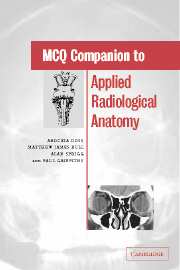Musculoskeletal and soft tissue (including trauma)
Published online by Cambridge University Press: 04 February 2010
Summary
The following are true:
(a) The supraspinatus tendon passes above the acromion process.
(b) The clavicle has a medullary cavity.
(c) The rhomboid fossa marks the site of origin of the costo-clavicular ligament.
(d) The clavicle is the last bone to ossify.
(e) A distance of less than 5 mm between the humerus and the acromion indicates likely supraspinatus tendon impingement.
Regarding the shoulder joint:
(a) The capsule of the shoulder joint is lax inferiorly.
(b) The long head of the biceps runs under the transverse humeral ligament.
(c) The subscapularis bursa is a herniation of the shoulder joint synovial membrane deep to the subscapularis muscle, through a defect in the glenohumeral ligament.
(d) Teres major forms part of the rotator cuff.
(e) During shoulder arthrography contrast passes normally into the subacromial bursa.
Regarding the shoulder joint:
(a) CT arthrography is of value in the assessment of the glenoid labrum.
(b) T2-W images and STIR (short tau inversion recovery) sequences with fat suppression can identify tears in the supraspinatus tendon.
(c) On ultrasound, the supraspinatus tendon is echobright.
(d) In anterior dislocation of the shoulder, cortical defects may occur in the anterior aspect of the head of the humerus.
Musculoskeletal and soft tissue (including trauma)
ANSWERS
(a) False – below the acromion.
(b) False – there is no medullary cavity because of its mesenchymal origin.
(c) True – in 5% of individuals an irregular groove is in the inferomedial aspect of the clavicle from which the costoclavicular ligament arises to insert into the first costal cartilage.
(d) False – first bone to ossify, formed in membrane, appears after the first fetal month.
(e) True
- Type
- Chapter
- Information
- MCQ Companion to Applied Radiological Anatomy , pp. 30 - 46Publisher: Cambridge University PressPrint publication year: 2003



